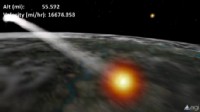Some 26 chunks of the old NASA satellite -- roughly the size of a bus -- will be dropping straight down at hundreds of miles per hour over an area of some 500 square miles at some point Friday night.
"We believe that the risk is sufficiently low that no one needs to, to change their behaviors," NASA's Mark Matney said Thursday.
As UARS – short for Upper Atmosphere Research Satellite - enters the atmosphere, everything changes. Bit by bit, pieces will cross the threshold about 60 miles up, enter the atmosphere and then drop straight down like stones -- travelling at several hundred miles an hour depending on their shape.
The chunks will fall at different points along the satellite's path, meaning debris will cover 500 miles.
NASA/Getty Images
The Upper Atmosphere Research Satellite... View Full Size
NASA Satellite: Narrowing Down the Impact Zone Watch Video
NASA Tracking Where Satellite Will Hit Watch Video
Animation: NASA Satellite's Final Plunge Watch Video
Bill Ailor, principal engineer of the Aerospace Corporation, studies incoming space junk for the Air Force. He says that some frighteningly huge pieces of other satellites have come crashing down into villages, farms-and random datelines around the planet.
"I actually think a lot of this kind stuff comes down and nobody knows what it is and just thinks it's junk and ignores it," Ailor told ABC News.
The Aerospace Corporation, a private firm that is tracking UARS, offered a more specific prediction, saying the satellite would likely come down off the coast of Chile at 6:06 p.m. EST.
Ailor said the time and location would almost undoubtedly change as Friday afternoon approaches. He and his colleagues study the materials they find in a lab to figure out what will burn up and what will become a potential threat -- just like the pieces of the UARS satellite.
But according to Nicholas Johnson, NASA's chief orbital debris scientist, any one person's chances of getting hit by debris are tiny -- something like 1 in 21 trillion. The chances that of the 7 billion people on Earth, one of them, somewhere, could be hit are more like 1 in 3,200.
Despite those odds, Ailor says that a hazard is a hazard.
"Five hundred pounds of stainless steel represents a hazard -- if you're standing under it," Ailor joked.
To say the least.
SatelliteAR Android app now tracks falling UARS, helps you avoid being smooshed

![Validate my Atom 1.0 feed [Valid Atom 1.0]](valid-atom.png)






























































Nenhum comentário:
Postar um comentário